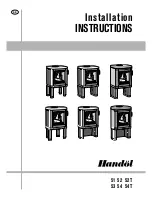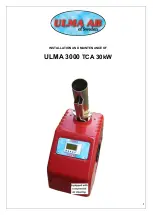
3
HHB5i 11/12/13
•
Create a seal with the fascia of the fireplace. Place hand through the stove flue collar and tighten the
wingnut onto the tightening bar. The fixing bar creates pressure when it contacts the chimney/lintel.
The stove should be tightly sealed to the fireplace fascia.
•
Insulate the space between the fireback and the stove – the back, top and sides of the box is well
insulated with 6:1 vermiculite/cement mix or any other good non-combustible insulating material.
•
Connect the connecting flue or flue liner/adaptor to the stove spigot and seal from the inside.
It is essential that a fireback is present where the insert stove is to be fitted.
3
Installation Instructions
WARNINGS AND IMPORTANT SAFETY INFORMATION
READ THESE INSTRUCTIONS CAREFULLY BEFORE INSTALLATION
It is very important to understand the requirements of the National Building Regulations(England
and Wales – Document J / Scotland - Part F/Document J (Republic of Ireland only) and standardsBS
8303, BS EN 15287-1, along with any local regulations and working practices that may apply. Should
any conflict occur between these instructions and these regulations then the regulations must apply.
Important Chimney Warning
This stove must not be installed into a chimney that serves any other heating appliance.
Extractor Fan Warning
There must not be an extractor fan fitted in the same room as the stove as this can cause the stove to emit
fumes into the room.
Cleaning and Chimney Sweeping
The appliance, flue & chimney must be cleaned and checked internally and externally regularly in use
and especially after a period on disuse (e.g. after summer).
Lift down the baffle at least weekly to check
for build up of soot or debris on the top from the flue pipe. Remove the baffle and check the flue spigot and
connector is fully clear at regular intervals. The chimney and flue connector must be swept at least annually
by a Hetas approved or suitably qualified chimney sweep, more often when used with sooty fuels or damp
wood. Any loose, broken or leaking joints or flue ways MUST be repaired immediately.Where the chimney
is believed to have a served an open fire installation it is possible that the higher flue gas temperature from a
closed appliance may loosen deposits that were previously firmly adhered, with the consequ ent risk of
flue blockage. It is therefore recommended that the chimney be swept a second time within a month of regular
use after installation.
Fuels
Only use recommended fuels. The appliance can be damaged by burning petroleum coke, liquid fuels or
general rubbish and this will invalidate your warranty and risk your personal safety.
The appliance must
not be used as a rubbish incinerator
.
Maintenance
Annual checking and servicing of the appliance and flue by a competent engineer is recommended.
Ventilation
No purpose provided ventilation is normally required for stoves rated under 5KW. However for
newer build properties or properties that have been modified so that the design air permeability is less than
5m
3
/h.m
2
a permanent ventilator will need to be fitted. Approved document J of the building Regulations
gives more detailed information. For each KW above 5KW, 550 sq mm of fixed ventilation is required – i.e.
Содержание HHB5i
Страница 15: ...14 HHB5i 11 12 13...


































